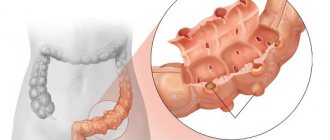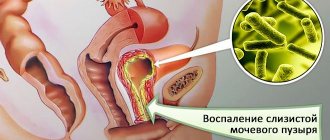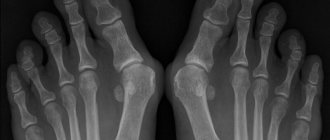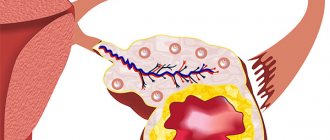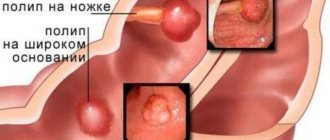Inflammation of the sigmoid colon is a disease that rarely occurs on its own and in most cases has concomitant diseases. This inflammation is also called sigmoiditis, from the Latin words “sigma” - a letter of the alphabet (this part of the intestine is similar to it) and the suffix “itis”, which means inflammation.
Where is the sigmoid colon located?
Sigmoiditis occurs more often in women, as well as in older people. We will now figure out where the inflamed area of the intestine is located and how it hurts.
What is sigmoiditis?
Acute or chronic sigmoiditis is an inflammation of the mucous membrane of the sigmoid colon, which is either an independent pathological process or a transient inflammatory process from other parts of the colon.
The sigmoid colon is projected onto the lower abdomen on the left and is the terminal part of the large intestine and continuously passes into the rectum.
The length of the sigmoid colon in different people can vary from 20 to 70 cm, and its course resembles the letter S.
The sigmoid colon is part of the structure of the massive colon, the length of which is 1-1.5 m, along with the ascending, descending and transverse colon.
Functions of the sigmoid colon:
- a natural reservoir for the vital activity of beneficial microflora, which is responsible for the synthesis of vitamins, the digestion of coarse fiber, the coordinated functioning of local immune defense and the formation of feces;
- the intestinal mucosa is capable of absorbing excess water and ions from food debris;
- active peristalsis of the sigmoid colon contributes to the accumulation of feces and their movement to the ampulla of the rectum and further physiological excretion.
Sigmoiditis occurs with equal frequency in adult men and women; older people are most susceptible to inflammation.
Therapeutic measures
Treatment of any disease is carried out in three directions:
- Etiological treatment. Aimed at eliminating the cause of the disease.
- Pathogenetic treatment. Aimed at eliminating the pathological mechanisms at the heart of the disease.
- Symptomatic treatment. Aimed at combating symptoms.
To implement these areas, medical and surgical treatment methods are used.
Surgical methods include:
- Bowel resection (removal of the intestine).
- Endoscopic removal of polyps.
Surgical treatment is primarily used in the treatment of polyps and cancer processes; there is no complete drug replacement. Chemotherapy is prescribed as an adjuvant treatment.
To treat diseases of the sigmoid colon, drugs from different pharmaceutical groups are used:
- antibacterial drugs (mesalazine, cyclosporines).
- antispasmodics (no-spa, papaverine).
- antidiarrheals (loperamide, smecta).
- laxatives (Forlax, Duphalac).
- prokinetics (motilium, itopride).
- enzymatic preparations (micrazim, festal).
- hemostatic agents (epsilon-aminocaproic acid, sodium ethamsylate).
- glucocorticosteroids (prednisolone, budesonide).
- cytostatics (azathioprine, methotrexate).
- anti-inflammatory (infliximab, etc.).
Causes of sigmoiditis
The anatomical structure of the sigmoid colon and the peculiarities of its functioning make this organ most vulnerable to the development of an inflammatory process in the intestinal wall.
Sigmoiditis is that special case of inflammation when the decisive role in its development is played not by the virulence and pathogenicity of harmful microorganisms and the toxicity of metabolic products, but by the structure of the organ.
The causes of the disease are:
- Frequent constipation. Insufficient consumption of fiber and fluid, or slower peristalsis of the upper parts of the large intestine leads to the formation of excessively dense feces, which can easily injure the mucous membrane of the sigmoid colon, causing its inflammation.
- Diverticulosis is the formation of small pouch-like expansions of the mucous membrane of the sigmoid colon, which accumulate feces and become inflamed. The disease often develops in childhood, but the first signs can appear in an adult.
- In women, inflammation of the sigmoid colon can develop in late pregnancy, when the enlarged uterus puts pressure on the organ and disrupts normal blood circulation in it.
- Acute intestinal infections (dysentery , salmonellosis , infection with staphylococcal toxins, yersiniosis, etc.) cause sigmoiditis through a direct pathogenic effect on the mucous membrane, the development of catarrhal or exudative inflammation and impaired absorption of nutrients.
- Intestinal dysbiosis. Disruption of the normal microflora due to antibiotic therapy or poor nutrition leads to a decrease in the body's resistance to infectious agents, and also provokes the development of constipation.
- Nonspecific ulcerative colitis (UC) and Crohn's disease are specific diseases that lead to the occurrence of erosive and ulcerative defects in the mucous membrane of the large intestine; the sigmoid colon is also involved in the process.
- Damage to the vessels of the mesentery of the sigmoid colon (atherosclerosis, arteritis). In this case, blood circulation in the intestinal wall is disrupted and microorganism toxins are more likely to cause an inflammatory process.
Possible consequences
Incorrect, untimely treatment of sigmoiditis leads to life-threatening complications. The consequences of the disease lead to death in a matter of days. Sigmoiditis is complicated by:
- toxic dilatation of the colon;
- perforation;
- massive bleeding;
- strictures and colonic obstruction;
- sepsis;
- peritonitis;
- thrombosis, thromboembolism;
- cancer.
In order to prevent serious consequences from occurring, it is imperative that when the first symptoms of intestinal dysfunction (diarrhea, constipation, bloating, flatulence, tenesmus, abdominal pain) appear, you should consult a gastroenterologist.
Classification of sigmoiditis
Inflammation of the sigmoid colon can occur in acute and chronic forms. Acute sigmoiditis is characterized by a bright and violent clinical picture; the disease lasts from 14 to 21 days. In a chronic process, there are no symptoms of sigmoiditis during the period of remission, and exacerbations occur from 4 to 10 times a year.
According to the morphological characteristics of the inflammatory process, the following types of sigmoiditis are distinguished:
- Mucous (catarrhal) . This type of inflammation is characterized by swelling and hyperemia of the mucous membrane of the sigmoid colon. A large amount of thick mucus is secreted into the intestinal lumen.
- Erosive-ulcerative . Defects form on the surface of the mucosa, affecting only the epithelium (erosions) or damaging the lower basement membrane (ulcers). Ulcerative sigmoiditis is a more dangerous variant of the disease, in which perforation and further peritonitis can occur.
- Perisigmoiditis . With this type of sigmoiditis, the inflammatory process involves the visceral peritoneum - a thin lining that covers the outside of the sigmoid colon, as well as the mesentery, through which arteries and veins pass. This type of inflammation is characteristic of adults who have a more developed and massive mesentery. As a result of inflammation, dense moorings and adhesions are formed between the intestinal loops, which can cause pain in the lower abdomen or acute intestinal obstruction.
Symptoms of sigmoiditis
The clinical picture of acute sigmoiditis develops over several hours. Sometimes the pain syndrome during acute inflammation is so severe that the patient’s condition is interpreted as “acute abdomen” - a surgical term that requires urgent diagnosis and assistance.
Symptoms of acute inflammation of the sigmoid colon:
- General intoxication syndrome . A massive release of metabolic products, bacteria and increased permeability of the intestinal wall lead to fever, severe weakness, decreased concentration and slower reactions. In some cases, patients experience psychomotor agitation and a feeling of severe anxiety.
- Diarrhea syndrome . There is an increase in bowel movements up to 8-10 times a day. Loose stools mixed with mucus and streaked with blood are accompanied by an unpleasant sour odor. Tenesmus, a false urge to defecate, is not uncommon.
- Pain syndrome . Cutting or cramping pain is localized in the lower abdomen on the left, which corresponds to the projection of the sigmoid colon onto the anterior abdominal wall. When you try to apply pressure to the area of pain, you may notice tension in the abdominal muscles. Pain with sigmoiditis in an adult is similar in its characteristics to pain with appendicitis or appendiceal abscess, however, the main difference is that with sigmoiditis the lower abdomen hurts on the left, not on the right.
- Dyspeptic syndrome . With sigmoiditis, signs of bloating and flatulence are detected. In some cases, vomiting of gastric contents may occur.
Chronic ulcerative sigmoiditis is characterized by blurred symptoms and unstable pain syndrome:
- Abdominal pain can be diffuse, spreading not only to the area of the lower abdomen on the left, but also to the periumbilical, pubic and right iliac regions. This is due to the involvement of the visceral peritoneum in the process and the development of perisigmoiditis.
- Diarrhea alternates with stools that are normal in frequency and design. The occurrence of constipation in chronic sigmoiditis is a poor prognostic sign, meaning advanced adhesive disease and intestinal obstruction. This phenomenon requires emergency surgical intervention.
- The patient's general well-being is characterized by a persistent decrease in appetite and constant weakness, and tolerance to physical activity decreases sharply.
Diet for sigmoid colon disease
It is very important to reduce the load on the intestines, and for this we need to review and somewhat diversify the daily menu with new food products. Fatty, fried, salty, smoked and spicy foods that disrupt normal bowel movements become forbidden. The therapeutic diet for sigmoiditis provides a favorable prognosis for the disease, the main thing is to strictly follow it. The list of useful products against the expansion of the pathological focus is as follows:
- light soups with vegetable and lean meat broth;
- skim cheese;
- boiled or steamed vegetables;
- brown rice;
- baked or boiled potatoes.
Complications of sigmoiditis
Erosive-ulcerative sigmoiditis is most susceptible to complications due to the formation of defects in the mucous membrane of the sigmoid colon. The most common complications:
- perforation of the intestinal wall is a dangerous condition due to the release of infected liquid contents of the intestine into the free abdominal cavity. Even a small amount of feces is enough to develop a life-threatening condition - peritonitis;
- peritonitis - inflammation of the parietal and visceral layers of the peritoneum. With peritonitis, the abdominal area becomes sharply rigid - a “board-shaped abdomen”, decompensation of the functioning of all organ systems occurs, which can lead to death. In this condition, the symptoms of sigmoiditis fade into the background, because in the terminal stage of peritonitis the pain syndrome completely disappears due to ischemia and necrosis of the nerve fibers of the intestinal wall;
- acute mechanical intestinal obstruction;
- bleeding from the intestinal wall. The sigmoid colon mucosa is a richly vascularized area, so even small perforations of arteries and veins can lead to massive bleeding. Without urgent surgery and intravenous infusion of blood plasma, death can occur within a few hours;
- cicatricial stenosis of the sigmoid colon. Severe post-perforation deformation of the intestinal area leads to disruption of adequate passage of feces and leads to chronic constipation and flatulence;
- malignancy - an ulcerative defect in a normal area of the mucosa can lead to the appearance of atypical (malignant) epithelial cells. Their rapid reproduction and growth leads to a dangerous complication of sigmoiditis - cancer of the sigmoid colon. A malignant neoplasm in its clinical picture resembles the symptoms of sigmoiditis, and therefore requires a more in-depth diagnosis.
Diagnosis of sigmoiditis
If you suspect sigmoiditis, you should consult a coloproctologist. During a physical examination of the patient, the doctor detects pain on palpation in the area of the sigmoid and rectum, as well as signs of flatulence and tension in the anterior abdominal wall.
Laboratory diagnosis of sigmoiditis is nonspecific and does not reflect the signs of the disease: a general blood test can only reveal an increase in the level of leukocytes, which indicates an inflammatory process in any organ.
For differential diagnosis of sigmoiditis, the doctor resorts to instrumental examination methods:
- sigmoidoscopy - examination of the terminal parts of the colon using a flexible endoscope. This method helps to visualize the sigmoid colon mucosa. Congestion, swelling, an abundance of purulent or mucous exudate in the lumen and detection of ulcerative defects will help to judge acute or chronic sigmoiditis;
- diagnostic laparoscopy of the abdominal cavity - intraoperative examination of the abdominal cavity through an access in the anterior abdominal wall. This method is used in difficult cases to differentiate acute appendicitis and intestinal tumors, because the symptoms of sigmoiditis imitate the picture of these diseases.
Do I need to take antibiotics?
Infectious sigmoiditis of bacterial origin usually does not require systemic antibiotics. The required therapeutic effect can be achieved by using selective drugs that include nifuroxazide. In severe cases, penicillin antibiotics may be prescribed: Ospamox, Flemoxin, Augmentin. Preference is given to combinations of amoxicillin and clavulanic acid, but the acid component may be contraindicated if there are signs of mucosal ulceration, so any antibiotics should be selected by the attending physician.
"Augmentin"
Prevention of sigmoiditis
Sigmoiditis can be prevented, because the symptoms and treatment of this disease can become debilitating and dangerous for the patient. Prevention consists of:
- compliance with the rules of rational nutrition - compliance with the drinking regime, consumption of fermented milk products, reducing the amount of refractory fats and salt in the daily diet;
- avoiding bad habits;
- refusal to independently take irrational antibiotics, which can harm the normal intestinal microflora.
Treatment
Treatment of sigmoiditis is complex. It is aimed at:
- eliminating the cause of the disease;
- reduction of the inflammatory process;
- healing of ulcers;
- preventing relapses.
To get rid of the disease, you must stop smoking, adhere to a special diet, and completely complete the course of treatment prescribed by your doctor. Well, as a complement to the main therapy (after preliminary consultation with a specialist), use traditional methods.
Diet
Enteral nutrition is a mandatory component of the treatment of sigmoiditis. In case of exacerbation of the disease, treatment table No. 4 is recommended.
It is not advisable for patients to use:
- milk;
- fresh vegetables and fruits (they can only be boiled or thoroughly ground);
- spices;
- fresh flour products;
- canned food;
- honey, jam.
When selecting dishes, it is taken into account that patients need easily digestible protein, and fats must be limited. Recommend:
- white bread crackers;
- weak meat broths;
- slimy soups (buckwheat, rice);
- grated meat (lean), steamed;
- egg white omelet;
- lean fresh fish;
- butter;
- cottage cheese;
- weak tea;
- jelly;
- decoction of black currants, blueberries.
Diet is not only about selecting permitted foods. If you have sigmoiditis, you need to eat every 2–3 hours (it is not recommended to eat before going to bed or at night), in small portions.
If the patient suddenly loses weight, or sigmoiditis occurs in a fulminant form, patients are shown parenteral nutrition. Intravenous administration of glucose solutions, electrolytes, protein preparations, intralipid, lipofundin is prescribed.
Be sure to read:
The causative agent of shigellosis, its symptoms and treatment
Drugs
For the treatment of sigmoiditis the following is prescribed:
- Basic anti-inflammatory. For mild cases of the disease, 5-aminosalicylic acid preparations (salofalk, mesalazine, pentas) are prescribed. In severe cases, corticosteroids. For sigmoiditis, it is more advisable to use them topically in the form of rectal suppositories and enemas.
- Antispasmodics. Relieve muscle spasm, eliminate pain.
- Antidiarrheal drugs. Prescribed: Loperamide, Smecta, Enterosgel.
- Antiulcer. They are prescribed for the rapid healing of ulcers and erosions.
- Probiotics. They are necessary to restore intestinal microflora.
For autoimmune reactions, immunosuppressants are prescribed.
For the treatment of ischemic sigmoiditis, drugs are prescribed that restore and improve blood circulation. Surgery is often required. Therefore, consultation with a vascular surgeon or angiologist is necessary.
If the disease is severe or complications arise, surgical treatment is mandatory.
Folk remedies
Traditional methods of treatment are used as an additional component of complex treatment. They are recommended to relieve symptoms of the disease. Since defecation is painful with sigmoiditis and proctosigmoiditis, it is recommended to induce stool with an enema with chamomile infusion.
For diarrhea with bloody discharge, drink decoctions from:
- rhizomes of Potentilla erecta;
- rhizomes of burnet;
- shepherd's purse herbs.
To reduce fermentation and putrefactive processes, decoctions are prescribed:
- oak bark;
- alder cones;
- bird cherry fruit.
Traditional methods do not treat sigmoiditis, but only reduce the manifestations of the main clinical manifestations. If you refuse to diet, and even more so take medications, complications of sigmoiditis will arise.
Read more: Herbs for the intestines: names of medicinal plants and their use
